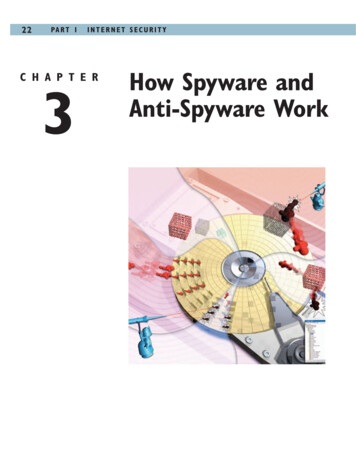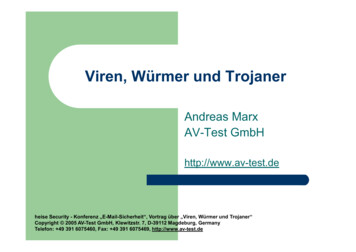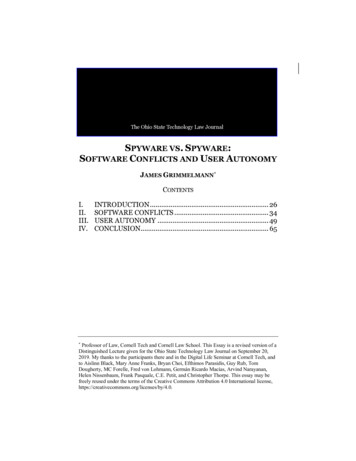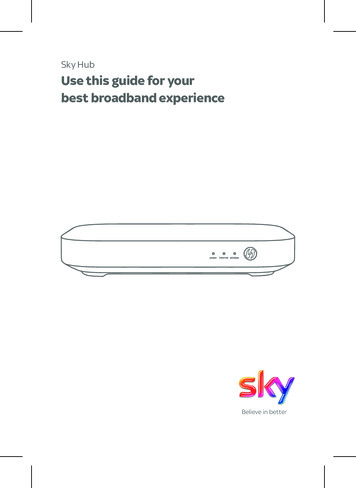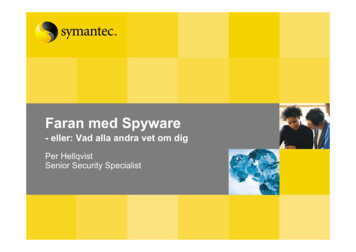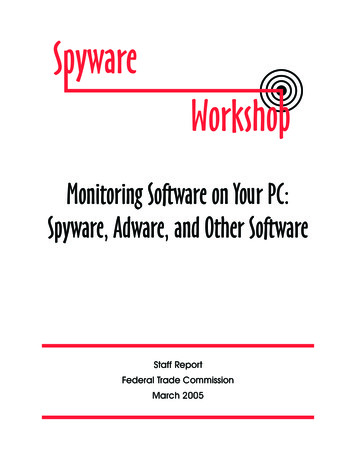
Transcription
SpywareWorkshopMonitoring Software on Your PC:Spyware, Adware, and Other SoftwareStaff ReportFederal Trade CommissionMarch 2005
Monitoring Software on Your PC:Spyware, Adware, and Other SoftwareFederal Trade CommissionDeborah Platt Majoras, ChairmanOrson Swindle, CommissionerThomas B. Leary, CommissionerPamela Jones Harbour, CommissionerJon Leibowitz, Commissioner
Federal Trade CommissionTable of ContentsI. INTRODUCTION .1II. DEFINING AND UNDERSTANDING SPYWARE AND ITS DISTRIBUTION .2A. Defining Spyware.21. Challenges in Defining Spyware .32. Classifying Adware as Spyware.33. Legislative and Regulatory Definitions of Spyware .44. Issues for Future Resolution .4B. Prevalence and Distribution of Spyware.51. Prevalence of Spyware .52. General Methods of Distributing Spyware .53. Distribution Methods That Exploit Browser Vulnerabilities .64. Distribution Methods That Use Deceptive Tactics .65. Prevalence of the Various Spyware Distribution Methods .7C. Difficulties of Removing Spyware.7III. THE EFFECTS OF SPYWARE .8A. Impact of Spyware on Computer Operation .8B. Browser Hijacking and Other Changes to Settings or Files .9C. Privacy and Confidentiality Risks.91. Consumer Privacy .92. Confidential Business Information .10D. Security Risks and Similar Harms .101. Interference with Security Tools .102. Increased Risks of Unauthorized Access by Hackers .103. Usurping Users’ Computers .114. Security Impact on Businesses.11E. Other Costs of Spyware .111. Costs of Responding to Calls to Tech Support .112. Costs Resulting from Lost Sales .12F. Potential Benefits of Spyware to Consumers or Competition .12IV. INDUSTRY RESPONSES TO SPYWARE CONCERNS .13A. Technological Solutions .131. Basic Security Protections .132. Anti-Spyware Software .143. Possible Actions at the Network Level .154. Changes to Windows XP Operating System .155. Possible Future Changes to Browsers or Operating Systems .16B. Best Practices and Self-Regulation .17C. Consumer Education .18D. Assistance to Government Law Enforcement.19
Federal Trade CommissionV. GOVERNMENT RESPONSES TO SPYWARE .19A. Law Enforcement .191. FTC Law Enforcement .202. Criminal Law Enforcement.21B. Legislation.221. Proposed Federal Legislation.222. State Legislation.22C. Consumer Education .23D. International Cooperation .23VI. CONCLUSION .24ENDNOTES .25Appendix A: Workshop AgendaAppendix B: Security Warning DisplayedAppendix C: “Cancel” Means “Yes”Appendix D: Faux Security Alert
Federal Trade CommissionI. INTRODUCTIONOn April 19, 2004, the Federal Trade Commission (FTC)1 sponsored Monitoring Softwareon Your PC: Spyware, Adware, and Other Software, a one-day public workshop to explore theissues associated with computer software known as “spyware.”2 The workshop featured sixpanels made up of 34 representatives from the computer industry, the electronic advertisingindustry, anti-spyware product industry, trade associations, government agencies, consumer andprivacy advocacy groups, and other interested parties. Panel topics included:# Defining, Understanding, and Disseminating Spyware;# Security Risks and PC Functionality;# Privacy Risks;# Industry Responses to Spyware – Industry Best Practices and Working with theGovernment;# Technological Responses to Spyware; and# Government Responses to Spyware – Law Enforcement, Consumer Education, andCoordinating with Industry.One purpose of the workshop was to broaden the FTC’s understanding of the informationpractices of the online marketplace and their impact on consumers, and to continue the FTC’slongstanding tradition of facilitating initiatives that foster privacy protection and security. Theworkshop also was intended to provide information that would inform the public debate overspyware and assist government, businesses, and consumers in developing effective responses tospyware.3FTC staff has prepared this report to present information concerning the issues discussedat the workshop. Part I of the report provides an overview of the issues the report covers and asummary of FTC staff’s conclusions. Part II discusses defining spyware, how it is distributed,and the challenge of uninstalling spyware from computers. Part III describes the effects ofspyware, including its impact on computer performance and its creation of privacy and securityrisks. Part IV discusses industry efforts to address spyware through technological innovation,self-regulation, and consumer education. Part V describes government efforts to addressspyware through law enforcement, legislation, and consumer education measures. Part VIprovides a brief conclusion.As explained in detail below, based on the information received in connection with theworkshop4 and other available information, FTC staff concludes: It is difficult to define spyware with precision. The working definition proposed forpurposes of the workshop was software that aids in gathering information about aperson or organization without their knowledge and which may send such informationto another entity without the consumer’s consent, or asserts control over a computerwithout the consumer’s knowledge. Panelists and commenters agreed that this was auseful starting point for defining spyware.1
Federal Trade Commission However, the workshop discussions also highlighted additional challenges in definingspyware relating to what constitutes adequate consent, and what constitutes sufficientharm to merit software being labeled spyware. In FTC staff’s view, a consensusdefinition of spyware cannot be developed until fundamental issues concerning consentand harm are resolved. Spyware is distributed in the same ways as other software; it can be downloaded fromthe Internet, bundled with other software, transferred via peer-to-peer (“P2P”) filesharing networks, installed from CDs, or pre-installed on new computers. In addition,spyware may be distributed by instant messaging, emails, or web pages. Spyware is a serious and growing problem. Spyware can impair the operation of computers, causing them to crash andinterfering with the ability of consumers to use them. Spyware, especially keystroke loggers, can create substantial privacy risks. Spyware can assert control over computers, and use that control to create securityrisks and cause other harms. Spyware often is more difficult to uninstall than other types of software.The incidence of spyware can be decreased if the private sector and the government act,separately and in concert. Technological solutions – firewalls, anti-spyware software, and improved browsersand operating systems – can provide significant protection to consumers from therisks related to spyware. Industry should: (1) develop standards for defining spyware and disclosinginformation about it to consumers; (2) expand efforts to educate consumers aboutspyware risks; and (3) assist law enforcement efforts. Government should: (1) increase criminal and civil prosecution under existing lawsof those who distribute spyware; (2) increase efforts to educate consumers aboutthe risks of spyware; and (3) encourage technological solutions.II. DEFINING AND UNDERSTANDING SPYWARE AND ITS DISTRIBUTIONA. Defining SpywareThe first issue discussed at the workshop was the definition of “spyware.” Despite its recentvintage, the etymology of “spyware” is unclear. Until 1999, it appears that the term was used torefer to monitoring equipment such as small cameras.5 “Spyware” first began to be used in thecomputer software context in 1999 when Zone Labs used it in a press release for its Zone Alarmfirewall product.62
Federal Trade CommissionIn 2000, Gibson Research launched the first anti-spyware product, OptOut. Steve Gibson,the developer of OptOut, described spyware as “any software that employs a user’s Internetconnection in the background (the so-called ‘backchannel’) without their knowledge or explicitpermission.”7 The term “spyware” thus apparently was used at the outset to refer to software thatwas installed without the knowledge and consent of users and that operated surreptitiously.Spyware has evolved to have a variety of meanings.8 Panelists generally agreed thatreaching an industry consensus on one definition has been elusive because of the technicalcomplexity and dynamic nature of software.9 Several panelists observed that it is also difficult todefine spyware because consumers and the business community may differ on what they believeis appropriate behavior in distributing software and because harmful software may cause a widevariety of problems.101. Challenges in Defining SpywarePanelists identified three main conceptual challenges in reaching a consensus definitionof spyware. The first challenge concerns knowledge and consent. There appears to be generalagreement that software should be considered “spyware” only if it is downloaded or installedon a computer without the user’s knowledge and consent.11 However, unresolved issues remainconcerning how, what, and when consumers need to be told about software installed on theircomputers for consent to be adequate.12 For instance, distributors often disclose in an End UserLicensing Agreement (EULA) that there is additional software bundled with primary software,but some panelists and commenters did not view such disclosure as sufficient to infer consent tothe installation of the bundled software.13Second, another question is whether the definition should limit “spyware” to software thatmonitors and collects data relating to computer use. Such a definition would be consistentwith the fundamental concept that the software must “spy” on computer users.14 However, itpresumably would not include software that does not collect data but adversely affects computerperformance or otherwise interferes with the use of computers.15A final challenge in reaching consensus on the definition of spyware is determining thenature and extent of harm that the software must cause. For instance, some would treat softwarethat “trespasses” on a computer as spyware because they consider trespass to be per se harmful,16even if the software is otherwise benign or beneficial. In contrast, there was general consensusthroughout the workshop that software should cause some harm to users before being labeledspyware. There was disagreement, however, as to the type and magnitude of injury needed tomeet this definition.172. Classifying Adware as Spyware18In FTC staff’s view, adware aptly illustrates the challenges associated with developing aworkable definition of spyware. Adware is often bundled with other software programs, whichare frequently provided to consumers for free. Some types of adware monitor computer use(including websites visited), analyze that information to determine ads in which the users mightbe interested, and then display targeted ads to users based on this analysis.19 On the other hand,other types of adware do not monitor computer use and instead just serve advertising messagesto users.203
Federal Trade CommissionWorkshop panelists and commenters stated a range of views as to whether and when adwareshould be classified as spyware. Some panelists argued that adware is spyware if users have notreceived clear notice about what the software will do or have not provided adequate consent toits installation or operation.21 In turn, some types of adware would not meet some definitions ofspyware because they do not monitor computer use.22 Other workshop participants apparentlywould view adware as spyware if it causes consumers to receive pop-up ads,23 regardless ofwhether consumers are bombarded with such ads or just occasionally receive such ads.3. Legislative and Regulatory Definitions of SpywareBecause of the challenges of developing a workable definition of spyware, nearly allpanelists expressed the concern that legislation or regulations tied to a definition of the term“spyware” might define the term so broadly that it would inadvertently cover some types ofbeneficial or benign software.24 One panelist stated that overly broad legislative definitionsmight inadvertently regulate software that many users depend upon for a safe Internetexperience.25 In his view, for example, parental control software might be considered spywareunder a recently enacted Utah statute.26 This statute might also treat security programs that banksand financial institutions use to monitor and protect access to their online services as spyware.27Because of the concern that a legislative or regulatory definition of spyware might be toobroad, a number of panelists and commenters observed that it would be more productive toidentify and prohibit unfair or deceptive practices associated with software.28 Panelists expressedbroad support for the Consumer Software Working Group’s effort to identify and prevent specificactivities related to software that are unfair, deceptive, or devious.29 Rather than adopting newlaws to address spyware, some comments suggested that the government could challenge theseparticular acts and practices as unfair or deceptive in violation of Section 5 of the FTC Act.304. Issues for Future ResolutionFTC staff agrees that a common understanding of what is meant by the term “spyware”would be extremely useful in discussing spyware, the problems that it causes, and possiblesolutions to these problems. In connection with the workshop, FTC staff offered a workingdefinition of spyware, namely, “software that aids in gathering information about a person ororganization without their knowledge and that may send such information to another entitywithout the consumer’s consent, or that asserts control over a computer without the consumer’sknowledge.”31 Panelists and commentators generally agreed that this definition provided a goodstarting point for discussing spyware and how it affects consumers.32FTC staff believes that the workshop discussions and related information provided importantinsights concerning how to address the conceptual challenges associated with defining spyware.There appears to be broad agreement that spyware should be defined to include software installedwithout adequate consent from the user. It also appears that, because both monitoring softwareand non-monitoring software can cause harm to consumers, spyware should be defined to includesoftware regardless of whether it performs a monitoring function. Finally, to avoid inadvertentlyincluding software that is benign or beneficial, the term “spyware” should be limited to softwarethat causes some harm to consumers.4
Federal Trade CommissionFTC staff emphasizes that fundamental issues remain to be resolved before a clear anddefinitive definition of spyware can emerge. Software distributors should obtain consent toinstallation, yet there appear to be substantial differences of opinion as to what distributors mustdo to obtain such consent. Moreover, as discussed in Part III below, software installed withoutconsent can cause any wide variety of harms to consumers, but there appear to be substantialdifferences of opinion as to when software has caused the type and magnitude of harm to warrantbeing treated as spyware.33 In FTC staff’s view, these fundamental issues of consent and harmneed to be resolved before any common definition of spyware can be developed.B. Prevalence and Distribution of Spyware1. Prevalence of SpywareWorkshop participants generally agreed that spyware is becoming more prevalent onthe computers of U.S. consumers.34 However, the limited empirical evidence submitted inconnection with the workshop does not permit quantification of the extent to which spyware hasbeen disseminated. Researchers attempting to quantify such distribution have used definitionsof spyware that differed in whether they included adware and cookies.35 FTC staff believes thatif a consensus definition of spyware is developed, it would assist in assessing the prevalence ofspyware and changes in its prevalence.362. General Methods of Distributing SpywareSoftware distributors disseminate their products to consumers through many differentchannels. For example, original equipment manufacturers install some programs on computersbefore consumers purchase them. Users typically supplement these software programs withadditional programs they obtain from software retailers or download from software distributors’websites on the Internet.Spyware likewise may be distributed through these ordinary channels of softwaredistribution. According to some commenters, spyware may be included with software that anoriginal equipment manufacturer pre-installs on computers prior to purchase, or with programsthat users purchase from software retailers.37 It also may be “bundled” with other softwareapplications that may be made available to users at no cost, such as P2P file-sharing software,38screen savers, and games.39Participants described various other means by which spyware is distributed as well. Usersmay receive spyware embedded in files shared over P2P networks.40 Spyware may be distributedthrough email, including as an attachment to an email message, a hyperlink in an email message,or even in the email communication itself if it is in HTML format (i.e., the email’s contents aredisplayed as if it were a web page).41 Spyware may also be installed from a web page.42 Asdetailed below, participants emphasized that some spyware programs, particularly programsinstalled from web pages, are distributed by means that exploit browser vulnerabilities or usedeception to undermine the ability of consumers to decide whether to install software on theircomputers.5
Federal Trade Commission3. Distribution Methods That Exploit Browser VulnerabilitiesOne mechanism that web pages can use to install software is a technology called ActiveX.ActiveX is a tool designed by Microsoft to add interactive features to web pages.43 The ActiveXtechnology is built into Microsoft’s Internet Explorer (“IE”) browser. In turn, some web pagesinclude code (called an ActiveX control) designed to interact with the ActiveX technology inthe IE browser. This interaction may result in the installation of additional browser-operatedsoftware programs, such as the Google search toolbar. Spyware developers can also use theActiveX technology to install their programs.As explained by a panelist from Microsoft, usually before an ActiveX-based programinstalls, a Security Warning dialogue box displays, telling a user the name of the programand asking if the consumer wants to install it.44 Unless the user clicks on the “Yes” button,the program should not install.45 However, some users change their IE Security settingsfrom Medium – the default setting – to Medium Low or Low. At these settings, no SecurityWarning Box is displayed, and the software is installed without notice.46 In short, by loweringtheir Security settings, these users have made themselves particularly vulnerable to the hiddeninstallation of spyware.A tactic known as a “drive-by” download allows spyware to be installed even if the IEdefault security level is unchanged. This tactic looks for various security vulnerabilities in the IEbrowser that will allow software to be installed from a web page without displaying the ActiveXSecurity Warning box.47 Drive-by spyware distributors insert code into web pages, and this codeexploits various IE browser vulnerabilities to install software without a Security Warning boxbeing displayed.48 Because users never see the Security Warning box, they do not know that theweb page is installing spyware.49Even if the Security Warning dialogue box is displayed, spyware distributors may use othertechniques to undermine or misuse the ActiveX warning process. For example, some spywaredistributors bombard consumers with prompts requesting permission to install software untilconsumers finally click “Yes.”50 Others may insert misleading or confusing information in the“Do you want to install” dialogue box.51 Consumers may click “Yes” to authorize the installationwithout really understanding the purported disclosure.4. Distribution Methods That Use Deceptive TacticsParticipants also described various deceptive tactics that distributors may employ to installspyware. Some of these techniques mislead users about the identity of the entity requestingpermission to install software. One such technique is the “pop-under exploit.”52 With thistechnique, for example, users visiting their favorite news website are presented with a SecurityWarning dialogue box asking if they want to install a software program. These users may click“Yes” because they believe that the request is from the operator of the news website. In fact, theperson seeking permission may be the operator of a totally unrelated web page hiding underneaththe news website’s page.Other distributors mislead consumers about the source of a program through the use of fakemessages that have been formatted to mimic a message that their Windows operating systemwould generate.53 These fake “operating system” messages typically ask for consent to install6
Federal Trade Commissionsoftware to fix a purported operating system problem. In fact, the “message” is from an entitythat is distributing spyware.In still another deceptive download technique described by participants, distributorsmay display what appears to be a window asking whether users want to install software. The“window” gives users the choice of clicking on a “Yes/OK” button, a “No/Cancel” button, oran “X” to close the “window.”54 In fact, the “window” may simply be an image embedded in aweb page; clicking anywhere in this image, including on the “No/Cancel” button, or on the “X,”initiates installation of the spyware program.555. Prevalence of the Various Spyware Distribution MethodsNo panelist pointed to any statistics or knew of any studies showing how often eachdistribution method described above is used. One anti-spyware company stated that, in itsexperience, bundling of spyware with other programs is the most common distribution method.56However, it is difficult to determine the frequency with which the various distribution methodsare used without a common definition of the term “spyware.” Moreover, even with a commondefinition, it is often not clear to consumers or sometimes even software experts how a specificspyware program was loaded onto a particular computer. FTC staff therefore believes that publicor private entities with expertise in the software industry should conduct further research onthe different methods of disseminating spyware to assist in developing effective responses tospyware.C. Difficulties of Removing SpywareSoftware programs can usually be deleted with relative ease by using the Add/RemovePrograms feature that the Windows operating system provides.57 In other cases, a program mightprovide its own uninstaller. Several participants noted that spyware programs, in contrast, oftencannot be removed using the Add/Remove Programs function and do not provide their ownuninstaller.58Workshop participants also elaborated on various additional reasons why spyware can bedifficult to remove. One stated reason is that spyware programs may install as many as 4,000files and make up to 2,000 changes in the computer’s Registry (the basic configuration file formost computers with a Windows-based operating system).59 To delete the spyware program,many of these files would have to be removed, and the Registry changes reversed or deleted.60Editing or revising Registry files creates a great risk that users will accidentally remove thewrong file, alter the wrong setting, or otherwise render their operating system or individualprograms inoperable.61Spyware distributors may also deliberately employ tactics that make their programs difficultto remove. For example, many spyware programs constantly change the file names and folderlocations they use, thereby evading detection and removal by anti-spyware products.62 Spywareprograms may also hide themselves by using well-known file names belonging to legitimateprograms.63 Further, because multiple spyware programs may be installed with a single click,even if users delete the spyware program they are aware of, other spyware programs may remaininstalled.647
Federal Trade CommissionFinally, several panelists explained that even if users delete a spyware program, it mayreturn on its own. In some cases, spyware accomplishes this by leaving a “trickler” behind whena user deletes it. The trickler gradually re-downloads, or “trickles down,” bits and pieces ofthe spyware whenever the user is online, until the spyware is complete and operational again.65Other spyware programs actively re-install themselves or their settings as quickly as someonedeletes them. These programs have two programs in memory. When one program is deleted, theother program will re-load the deleted program and any deleted Registry settings.66In short, given the general lack of any easy means of uninstalling and the use of tacticsto resist removal, FTC staff concludes that most spyware is more difficult – often much moredifficult – to remove from computers than other software. This exacerbates the adverse effects ofspyware described below.III. THE EFFECTS OF SPYWAREFTC staff concludes that spyware can harm computer operation and performance, increaseprivacy and confidentiality risks, make computers less secure, and impose significant costs onbusinesses. Panelists and commenters presented no empirical data, however, that quantified thenature and extent of these harms or benefits.A. Impact of Spyware on Computer OperationSpyware programs often cause significant degradation in system performance. Significantlyslowed computer performance is the number one spyware-related complaint that computermanufacturer Dell receives, accounting for more than a quarter of all spyware-related complaintsas of April 2004.67 Spyware can even cause computers to crash. Microsoft reported that 50% ofits customers’ computer crashes are traceable to spyware.68 According to panelists, spyware mayuse so many system resources that users are no longer able to use
For instance, some would treat software that "trespasses" on a computer as spyware because they consider trespass to be per se harmful,16 even if the software is otherwise benign or beneficial. In contrast, there was general consensus throughout the workshop that software should cause some harm to users before being labeled spyware.
